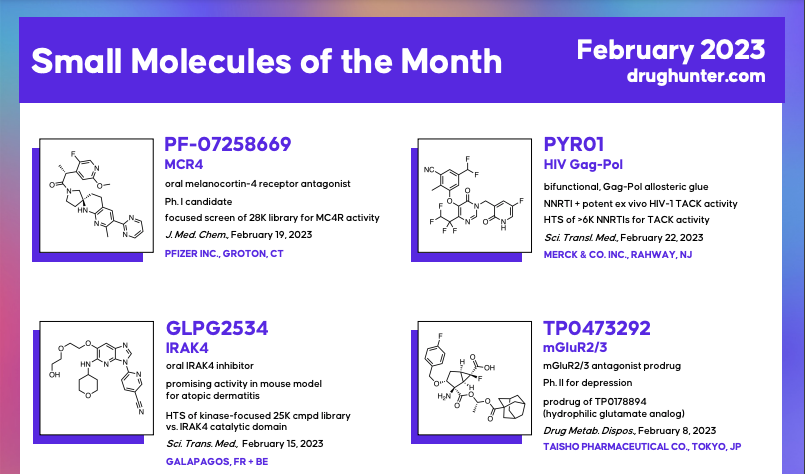In February, Actelion revealed the discovery story of nivasorexant, the first selective orexin-1 receptor antagonist, which completed a Ph. II clinical trial in binge-eating disorder. Additional molecules to make the top ten include a brain-penetrant S2R modulator currently in clinical development for Alzheimer’s disease and an orally bioavailable BTK degrader that has advanced into first-in-human clinical trials for relapsed/refractory B-cell malignancies. NodThera released exciting new details on their two clinical NLRP3 inflammasome inhibitors NT-0796 and NT-0249, which exhibit similar efficacy to the GLP-1 mimetic semaglutide in reversing pre-established obesity. Also featured this month is cilofexor, an intestinally biased FXR agonist discovered by Phenex Pharmaceuticals, and a potent and selective preclinical CDK2 inhibitor from Incyte.
You can check out the recent articles about the February 2024 Molecules of the Month linked below:
nivasorexant – An oral and selective OX1 receptor antagonist from Actelion, the first to enter clinical development, which recently completed a proof-of-concept Ph. II clinical trial in binge-eating disorder.
ACT-1016-0707 – A potent, orally active LPAR1 antagonist from Idorsia with demonstrated efficacy in a mouse vascular leakage target engagement model selected for preclinical development for the treatment of fibrotic diseases. Notably, ACT-1016-0707 is structurally distinct from previously disclosed LPAR1 antagonists, which may help to differentiate it from other clinical candidates hampered by hepatobiliary toxicity issues.
CT1812 – A brain-penetrant small molecule modulator of the sigma-2-receptor with a unique mechanism of action from Cognition Therapeutics that is currently in clinical development for the treatment of Alzheimer’s disease.
AZD1390 – A potent and selective inhibitor of ataxia telangiectasia mutant kinase (ATM) from AstraZeneca with good preclinical PK and significant brain exposure in NHP PET studies that was selected for clinical development to explore the radiosensitizing effects of ATM in intracranial malignancies.
TYA-018 – A preclinical small molecule HDAC6 inhibitor from Tenaya Therapeutics that shows preclinical efficacy in a heart failure with preserved ejection fraction (HFpEF) male mouse model. Notably, TYA-018 shows enhanced efficacy in combination with an SGLT2 inhibitor and is an interesting example of HDAC inhibitors outside of oncology.
NT-0249 – An oral, selective, peripherally restricted NLRP3 inflammasome inhibitor for the treatment of obesity, systemic inflammation, and astrogliosis from NodThera that was safe and well tolerated in a Ph. I ascending dose study with a potentially best-in-class PK/PD profile.
NX-2127 – An orally bioavailable BTK degrader from Nurix Therapeutics that exhibits in vivo degradation across species and has advanced into first-in-human clinical trials for relapsed/refractory B-cell malignancies.
BAY-9835 – A potent, selective, and orally bioavailable preclinical inhibitor of the matrix metalloprotease ADAMTS7 for atherosclerosis from Bayer AG that showed good tolerability in a two-week rat toxicology study.
cilofexor – A potent, non-steroidal, and intestinally biased FXR agonist discovered by Phenex Pharmaceuticals and acquired by Gilead that demonstrated antisteatotic and antifibrotic efficacy in preclinical models, exhibited a manageable safety profile in Ph. I studies, and has advanced to Ph. III for primary sclerosing cholangitis.
compound 17 – A preclinical CDK2 inhibitor with selectivity over CDKs 1, 4, 6, 7, and 9 from Incyte that shows PD inhibition of CDK2, measured by reduced Rb phosphorylation, and antitumor activity in mouse models.
Reviewer Commentary on Idorsia’s ACT-1016-0707 from Christian Kuttruff
What is particularly notable in the Idorsia publication is the fact that they started from scratch with an HTS screening campaign that led to a hit with mediocre potency. Through rigorous SAR analysis of the individual parts of the molecule, and without X-ray or cryo-EM support, they optimized to potent and selective LPAR1 antagonists. Notably, their candidate is structurally distinct from previously disclosed LPAR1 antagonists (most of which have been following a knowledge-based design or patent-busting approach) and does not necessarily require a carboxylic acid functional group (they also have neutral or even basic derivatives in their paper with high potency).
Reviewer Commentary on Incyte’s Compound 17 from Charles Cole
The family of cyclin-dependent kinases (CDKs) are an interesting and well-studied class of targets. Their primary role in cell cycle progression makes their implication as a key oncogenic driver quite apparent. Original approaches to CDK inhibition did not heavily focus on isoform selectivity, instead generating pan-inhibitors. Unfortunately, many of these failed to show suitable safety profiles and/or efficacy in the clinic. The subsequent generation sought instead to target CDKs in a more isoform-selective manner, particularly targeting CDK4/6. This study, however, focuses on the design of a selective CDK2 inhibitor and much of the presented work follows the general theme of selectivity. Taking an HTS hit that was highly potent against JAK2, the authors performed a systematic SAR study focused on three main regions to generate a potent and selective compound for CDK2 inhibition. In addition, the authors present PK/PD and efficacy data that validate their therapeutic hypothesis and support the application of small molecule inhibitors against CCNE1-amplified cancers."
"There is a lot of discussion within the community about the role that selectivity should play in drug design. While many teams tend to impose strict selectivity requirements, either against other target isoforms or within the context of the broader kinome (with good reason), others will cite examples of successful FDA-approved drugs with notable off-target activity. While this is not an argument I would seek to settle here, this work nicely demonstrates the ability to achieve the desired efficacy and reduce off-target toxicity by improving target specificity.
Sign up for our free weekly newsletter here to get more content like this straight to your inbox.
